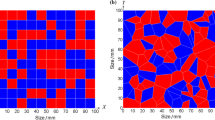Abstract
Numerical modeling data on evolution of the stress-strain state of a rock mass containing a karst cavity are reported.
Similar content being viewed by others
References
P. Williams and T. F. Yin, World Map of Carbonate Rock Outcrops, Version 3.0, Geography and Environmental Science, University of Auckland, http://www.sges.auckland.ac.nz/sges_research/karst.shtm, Aug. 27 (2009).
G. A. Maksimovich, “Fundamentals of karsts science,” in: Aspects of Karst Morphology, Speleology and Karst Hydrogeology [in Russian], 1, Perm Knizh. Izd., Perm (1963).
K. A. Gorbunova, V. N. Andreichuk, V. P. Kostarev, and N. G. Maksimovich, Karst and Caves of the Perm Region [in Russian], Izd. Perm Univers., Perm (1992).
G. Veni, H. DuChene, N. C. Crawford, C. G. Groves, G. H. Huppert, E. H. Kastning, R. Olson, and B. J. Wheeler, Living with Karst: a Fragile Foundation, Environmental Awareness Series, American Geological Institute (2001).
M. Parise and J. Gunn, “Natural and anthropogenic hazards in karst areas,” Natural Hazards and Earth System Sciences, Special Issue, No. 23 (2004).
W. E. Davies, J. H. Simpson, G. C. Ohlmacher, W. S. Kirk, and E. G. Newton, Engineering Aspects of Karst. Map, U. S. Geological Survey National Atlas of the United States of America, Scale 1:7,500,000, Reston, Va (1984).
S. V. Al“bov, “Interpretation of the origin of sink and subsidence origin in terms of the theory of rock pressure with the use of the karst information for the Oka left-shore lower reaches,” Karstoved., No. 4 (1948).
T. M. Tharp, “Cover-collapse sinkhole formation and soil plasticity,” Sinkholes and the Engineering and Environmental Impacts of Karst, Geotechnical Special Pub., ASCE, B. F. Beck (Ed.), No. 122 (2003).
C. E. Augarde, A. V. Lyamin, and S. W. Sloan, “Prediction of undrained sinkhole collapse,” J. Geotechnical and Geoenvironmental Engineering, 129, No. 3 (2003).
Eui-Seob Park, Sung-Oong Choi, and Hee-Soon Shin, “Simulation of the ground subsidence mechanism using a PFC2D,” Proc. Alaska Rocks 2005, The 40th U.S. Symposium on Rock Mechanics (USRMS), Anchorage, American Rock Mechanics Association, AK, USA (2005).
M. Caudron, F. Emeriault, R. Kastner, and M. Al. Heib, “Collapses of underground cavities and soil- structure interactions: Experimental and numerical models,” in: Proc. the First Euro-Mediterranean Symposium on Advances in Geomaterials and Structures, F. Darve, L. Doghri, R. El Fatmi, H. Hassis, and H. Zenzri (Eds.), Hammamet, Tunisia, LGC-ENIT, Tunisia (2006).
Itasca: Software: Particle Flow Code in Two Dimensions, http://www.itascacg.com/pfc2d.
P. A. Cundall and O. D. L. Strack, “A discrete numerical model for granular assemblies,” Geotechnique, 29 (1979).
H. T. Alassi, L. Li, and R. M. Holt, “Discrete element modeling of stress and strain evolution within and outside a depleting reservoir,” Pure and Applied Geophysics (2006).
G. N. Khan, “On unsymmetrical regime of rock mass failure in the vicinity of a cavern,” Phys. Mezomekh., 11, No. 1 (2008).
A. A. Baryakh, S. B. Stazhevsky, E. A. Timofeev, and G. N. Khan, “Strain state of a rock mass above karst cavities,” Journal of Mining Science, No. 6 (2008).
Monitoring of Exogenous Geological Processes in the Territory of the Perm Region [in Russian], GI UR O RAN, Perm (2005).
E. P. Dorofeev, “Relationship between size of cave-in pits and karst caverns in sulphatized rocks,” in: Karst Science Aspects [in Russian], Issue II, Perm (1970).
D. C. Ford and P. Williams, Karst Hydrogeology and Geomorphology, John Wiley and Sons (2007).
Author information
Authors and Affiliations
Corresponding author
Additional information
Translated from Fiziko-Tekhnicheskie Problemy Razrabotki Poleznykh Iskopaemykh, No. 6, pp. 3–10, November-December, 2009.
Original article submitted October 9, 2009
Rights and permissions
About this article
Cite this article
Baryakh, A.A., Rusin, E.P., Stazhevsky, S.B. et al. Stress-strain state of karst areas. J Min Sci 45, 517–524 (2009). https://doi.org/10.1007/s10913-009-0065-y
Published:
Issue Date:
DOI: https://doi.org/10.1007/s10913-009-0065-y




